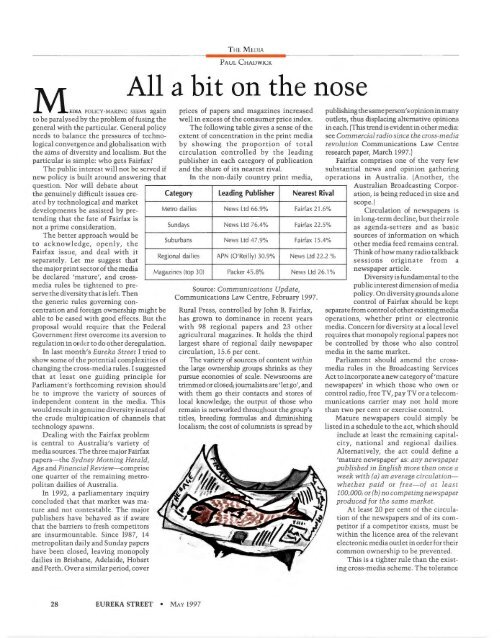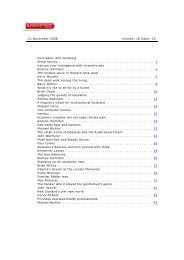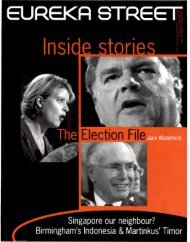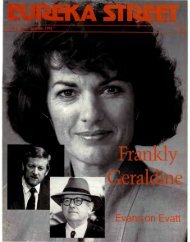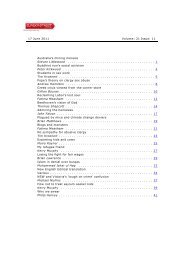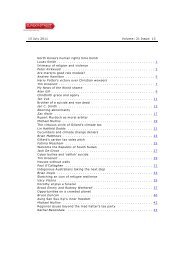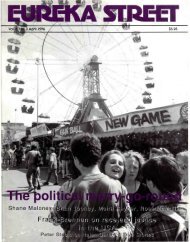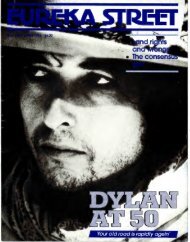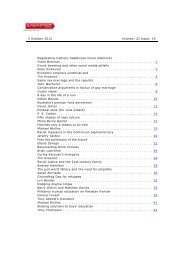n - Eureka Street
n - Eureka Street
n - Eureka Street
You also want an ePaper? Increase the reach of your titles
YUMPU automatically turns print PDFs into web optimized ePapers that Google loves.
POLICY-MAKING SEEMS againto be paralysed by the problem of fusing thegeneral with the particular. General policyneeds to balance the pressures of technologicalconvergence and globalisation withthe aims of diversity and localism. But theparticular is simple: who gets Fairfax?The public interest will not be served ifnew policy is built around answering thatquestion. N or will debate aboutthe genuinely difficult issues createdby technological and marketdevelopm ents be assisted by pretendingthat the fate of Fairfax isnot a prime consideration.The better approach would bet o ackn owl edge, openly, theFairfax issu e, and deal with itseparately. Let m e suggest thatthe major print sector of the mediabe declared 'm ature', and crossmediarules be tightened to preservethe di versity that is left. Thenthe generic rules governing concentrationand fo reign ownership might beable to be eased with good effects. But theproposal would require that the FederalGovernment first overcom e its aversion toregulation in order to do other deregulation .In last month's <strong>Eureka</strong> <strong>Street</strong> I tried toshow som e of the potential complexities ofchanging the cross-media rules. I suggestedthat at least one guiding principle forParliament's forthcoming revision shouldbe to improve the variety of sources ofindependent content in the media. Thiswould result in genuine diversity instead ofthe crude multipication of channels thattechnology spawn s.Dealing with the Fairfax problemis central to Australia's variety ofmedia sources. The three major Fairfaxpapers-the Sydney Morning Herald,Age and Financial Review-compriseone quarter of the remaining metropolitandailies of Australia.In 1992, a parliamentary inquiryconcluded that that m arket was matureand not contestable. The majorpublishers have behaved as if awarethat the barriers to fresh competitorsare insurmountable. Since 1987, 14metropolitan daily and Sunday papershave been closed, leaving m onopolydailies in Brisbane, Adelaide, Hobartand Perth. Over a similar period, coverTHE M EDlAPAUL CHADWICKAll a bit on the noseprices of papers and magazines increasedwell in excess of the consumer price index.The following table gives a sense of theextent of concentration in the print m ediaby showing the proportion of totalcirculation controlled by the leadingpublisher in each category of publicationand the share of its nearest rival.In the non-daily country print media,Category Leading Publisher Nearest Ri valpublishing the same person's opinion in manyoutlets, thus displacing alternative opinionsin each. (This trend is evident in other media:see Commercial radio since the cross-mediarevolution Communications Law Centreresearch paper, March 1997.)Fairfax comprises one of the very fewsubstantial news and opinion ga theringoperations in Australia. (Another, theAustralian Broadcasting Corporation,is being reduced in size andscope.)Metro dailiesSundaysSuburbansRegional dai liesNews Ltd 66.9%News Ltd 76.4%News Ltd 4 7.9%APN (O 'Reilly) 30.9%Fairfax 21. 6%Fairfax 22.5%Fairfax 15.4%News Ltd 22 .2%Circulation of newspapers isin long- term decline, but their roleas agenda-setters and as basicsources of information on w hichother m edia feed remains central.Think of how many radio talk backsessions originate fro m anewspaper article.Magazi nes (top 30) Packer 45.8% News Ltd 26 .1 %Source: Communications Update,Communications Law Centre, February 1997.Rural Press, controlled by Joh n B. Fairfax,has grown to dominance in recent yearswith 98 regional papers and 23 otheragricultural magazines. It holds the thirdlargest share of regional daily newspapercirculation, 15.6 per cent.The variety of sources of content withinthe large ownership groups shrinks as theypursue economies of scale. Newsrooms aretrimmed or closed; journalists are 'let go', andwith them go their contacts and stores oflocal knowledge; the output of those whoremain is networked throughout the group'stitles, breeding formulas and diminishinglocalism; the cost of columnists is spread byDiversity is fundamental to thepublic interest dimension of m ediapolicy. On diversity grounds alonecontrol of Fairfax should be keptseparate from control of other existing mediaoperations, whether print or electronicm edia. Concern for diversity at a local levelrequires that monopoly regional papers notbe controlled by those who also controlmedia in the same market.Parliam ent should amend the crossmediarules in the Broadcasting ServicesAct to incorporate a new category of 'maturenewspapers' in which those who own orcontrol radio, free TV, pay TV or a telecommunications carrier may not hold morethan two per cent or exercise control.Mature newspapers could simply belisted in a schedule to the act, which shouldinclude at least the rem aining capitalcity,national and regional dailies.Alternatively, the act could define a'mature newspaper' as: any newspaperpublished in English more than once aweek with (a) an average circulationwhetherpaid or free-of at least100,000; or (b) no competing newspaperproduced for the same market.At least 20 per cent of the circul ation of the newspapers and of its competitorif a competitor exists, must bewithin the licence area of the relevantelectronic m edia outlet in order for theircomm on ownership to be prevented.This is a tighter rule than the existingcross-m edia schem e. The tolerance28 EUREKA STREET • M AY 1997


